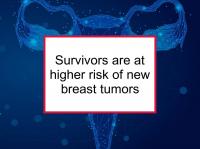Cancer survivors are known to have a 20% higher risk of new cancers than the general population. However, breast cancer survivors appear to have a somewhat lower rate of second primary cancers, perhaps because their cancers are hormonally driven and therefore do not share multiple risk factors with most other cancer types.
In fact, breast cancer survivors are most likely to be diagnosed with another primary breast cancer or endometrial cancer when they do develop another cancer, according to a new study. There is some evidence that some breast cancer treatments themselves can increase the risk of a second primary cancer and might possibly result in increased aggressiveness of new breast cancers that do arise. The implication is that breast cancer survivors must continue to get regular breast cancer screenings throughout their lives.
Second primary breast cancer
It is not always easy to distinguish between a breast cancer recurrence and a new primary breast cancer. Breast tumors that arise in the contralateral breast (the opposite or untreated breast) at least two years after the first breast cancer are assumed to be new primary tumors. It remains difficult to determine whether a locoregional relapse (in the original breast, chest wall, or lymph nodes) is a true recurrence or a second primary.
Latest research identifies most likely 2nd cancer sites
The study referenced at the beginning of this news article was designed to investigate the incidence of second primary tumors in breast cancer survivors. The study included 11,045 breast cancer patients in the European Prospective Investigation into Cancer and Nutrition (EPIC) study. The women were followed for a median of five years, during which time 492 second primary cancers were diagnosed.
A total of 140 (28%) of the tumors were second primary breast cancers, 65 (13%) were colorectal cancers and 39 (8%) were endometrial cancers. Leaving out non-melanoma skin cancer, the overall incidence of second primary cancers was slightly elevated compared to the general population, but this increase was not statistically significant. However, when individual cancer types were analyzed, study participants were found to have elevated risks of second primary breast and endometrial cancers. The authors conclude that second primary cancers may be an important problem for cancer survivors.
